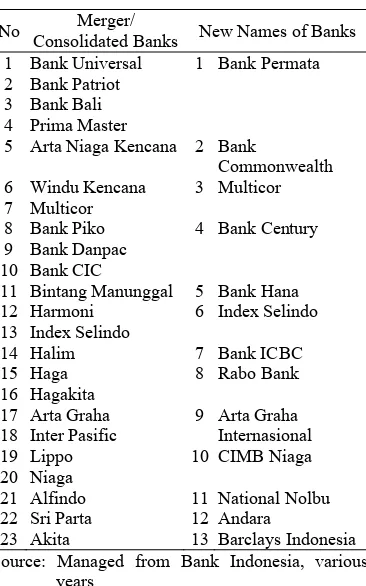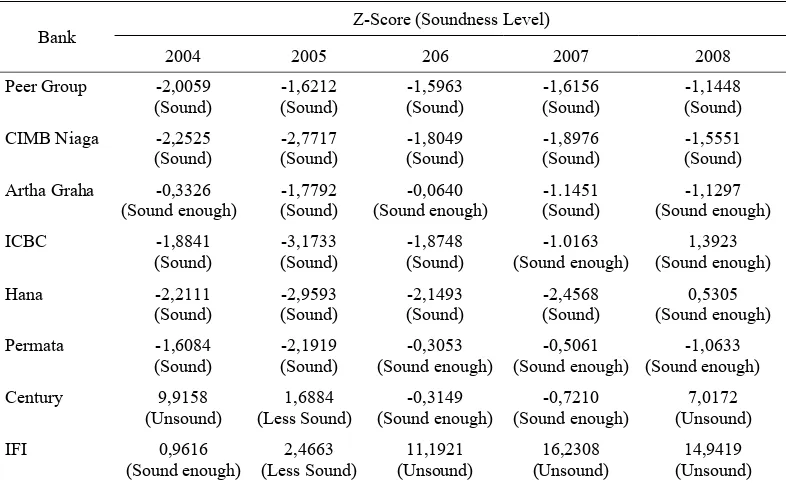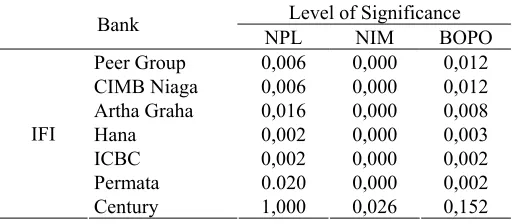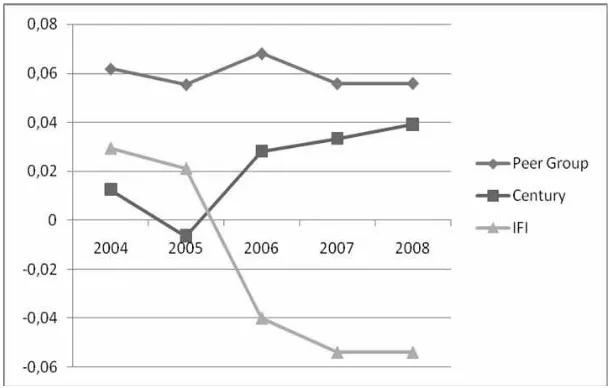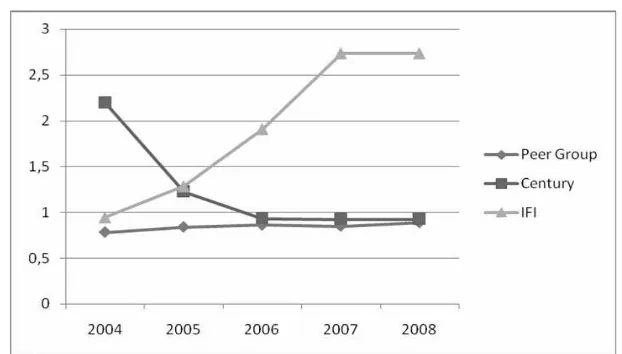Volume 26, Number 3, 2011, 359 – 370
INSOLVENT FOREIGN PRIVATE BANK:
A STUDY ON MERGER AND LIQUIDATED BANKS
Sri Haryati
STIE Perbanas Surabaya ([email protected])
ABSTRACT
The purpose of this research was to apply the result of the previous studies on predictive models of banks soundness in the year of 1999-2004 in private national banks, in which the result showed poor performance as was indicated by Z-score calculation of the discriminatory function of the cut-off position on less soundness and unsoundness level.
The study also examined whether the financial ratios that must be published according to SEBI No. 7/10/DPNP March 2005 are able to predict the level of banks soundness when they were implemented on the the discriminatory function.
The research population was Indonesian Foreign Private Bank (BUSN). The secondary data used in this research were publications of financial statement during the five-year perception time (2004-2008). The result of the research showed that the discriminatory function of previous research could apply to predict the soundness level of private foreign banks in the period 2004-2008 and the financial ratios according to SEBI7/10/DPNP publication in March 2005 were not enough to predict the soundness ratings of Indonesia’s Foreign Private Banks.
Keyworlds: soundness level of bank, Z-score, financial ratios
INTRODUCTION
The shutting down of banks is likely to occur on banking industry, bank can go bank-rupt because of its bad performance, which can result from economic crisis, poor manage-ment that puts aside alertness principles, and pays less attention on risk management and good governance. Bank liquidations in Indonesia during the monetary crisis of 1997 took place on 16 banks, and followed by 38 banks in 1999; the liquidation of Bank Dagang Bali and Bank Aspac because of its poor performance in 2004, and in 2005 the shutting down of Bank Global and in 2009 Bank IFI (Sugiarto, 2009). However, if banks could have improved their performance by doing merger, consolidation with other banks, the
institution sustainability would have been stronger, and therefore the shutting down would have never happened.
Bank Indonesia’s policy on banking con-solidation has been issued in 2004 to refer to banks with small capital in order that the insti-tution sustainability/capital becomes stronger; several national banks in Indonesia have done merger/consolidation/acquisition in order to remain existing and to meet the banking regulations that Bank Indonesia has required them to (Table 1).
whereas Bank IFI has been liquidated early 2009. It is interesting to study the developing phenomena of which occurred on Bank Cen-tury, which the government (Bank Indonesia) has secured by in the late 2008 until 2009 on the purpose of securing a wider financial sys-tem and that of which occurred on Bank IFI, which the government has shut down in the early 2009.
Table 1. Merger/Consolidated Banks in Indo-nesia, 2003-2009
No Merger/
Consolidated Banks New Names of Banks
1 Bank Universal 13 Index Selindo
6 Index Selindo 18 Inter Pasific
9 Arta Graha
Internasional 19 Lippo
20 Niaga
10 CIMB Niaga
21 Alfindo 11 National Nolbu
22 Sri Parta 12 Andara
23 Akita 13 Barclays Indonesia
Source: Managed from Bank Indonesia, various years
This study is aimed at applying the previ-ous research result to find out whether the outcome of model can measure the soundness of a bank shown by Zscore calculation of discriminatory function at cut-off position being less sound and unsound (Haryati, 2006). Besides, this study will study how the condition of soundness level of BUSN devisa
is, especially upon doing merger and upon being shut down in the very period.
This study will also study whether the financial ratio, which had to be publicized in accordance with PBI No.7/10/DPNP 31st of March 2005 (capital, asset quality, earning, liquidity and bank obedience), is able to pre-dict the level of soundness of bank. It will show whether it will produce the same Zscore, when it is implemented on discriminatory function, so that the society can predict the level of soundness of a bank through publi-cized reports.
LITERATURE REVIEW AND HYPOTHESIS DEVELOPMENT
regulatory risk, technological risk, affiliation risk, operating efficiency risk, and strategic risk.
The measurement of the level of sound-ness for Indonesian banking is settled by Bank Indonesia (SEBI 6/23/2004 May 2004) through financial ratios that consist of; capital, asset quality, liquidity, rentability and sensitivity towards market risk. Indonesian banking is also obliged to publicize financial report and financial ratio that can be indicators in judging the bank financial condition (SEBI 7/10/DPNP March 2005). It consists of (1) Capital: Capital Adequacy Ratio (CAR), Fixed Active Capital Ratio (FACR); (2) Asset Qual-ity: Non Performing Loan (NPL), Insolvent Productive Asset (APB/Aktifa Produktif Bermasalah), Classified Productive Asset (APYD/Aktiva Produktif Diklasifikasikan terhadap Aktifa Produktif), the Fulfillment of Segregation of Productive Asset Abolition (PPAP/Pemenuhan Penyisihan Penghapusan Aktiva Produktif), PPA Productive Asset Formed towards Productive Asset (PPAD/PPA Aktiva Produktif yang telah Dibentuk terhadap Aktiva Produktif); (3) Earning: Return on Asset (ROA), Return on Equity (ROE), Net Interest Margin (NIM), Operational Cost towards Operational Earning (BOPO); (4) Li-quidity: LDR; (5) Obedience: Maximum Credit Allowance (BMPK), Minimum Obliged Clearing (GWM) and Foreign Exchange Net Position (PDN).
The previous research that utilized cial performance to study the effect of finan-cial ratio towards banking condition shows that capital adequacy variable has significant negative effect towards insolvent/failed bank (Altman, 1982 in Sukristono, 1992; Indira and Dadang, 1998; Gilbert, 2002). The research outcome of Santoso (2000) CAR variable has significant positive effect and Gunther and Moore (2003) shows that the mentioned variable has insignificant negative effect towards the decrease of the bank soundness level of rating. Equity Multiplier (EM) and
Cumulative Profitability (CPR) variable has significant negative effect (Sukristono, 1992). The research outcome of Indira and Dadang (1998), Santoso (2000), Gilbert (2002); Gunther and Moore (2003); shows that Nonaccrual/NPL variable has significant positive effect towards problematic/failed/ insolvent/downgrade-rated bank. Variable that measures profitability, namely, ROA has sig-nificant negative effect towards problem-atic/bankrupt rated bank (Santoso, 2000; Haryati, 2001; Gilbert, 2002; Gunther and Moore, 2003). The research outcome shows that efficiency variable/BOPO has significant negative effect towards problematic bank, Haryati (2001). Variable that measures liquid-ity, namely, LDR has significant effect towards the bankruptcy of bank (Haryati, 2001). Somehow, the research of Santoso (2000), Indira and Dadang (1998) shows insignificant effect. Securities/IPR variable has insignificant effect towards downgrade-rated bank (Gilbert, 2002; Gunther and Moore, 2003). Size variable has significant effect towards failed/downgrade bank (Sukristono, 1992), while the research outcome of Gilbert (2002) and Gunther and Moore has insignificant effect.
The research outcome mentioned above is developed at BUSN in Indonesia (Haryati, 2006). It results in the use of discriminatory function as prediction model. Based on that function, it bears Cutting Score value where bank will be categorized sound if it has score of ≤ -1.140 and will fall into a category of sound enough, if it has -1.140 > score ≤ +1.665. It will fall into a category of less sound, if it has +1.665 > score ≤ +4.179, and will be categorized unsound, if it has > 4.179 score.
Classification of Category Credit Value Y0 = Sound, 81 to 100 Y1 = Sound Enough 66 - < 81 Y2 = Less Sound 51- < 66 Y3 = Unsound 0 - < 51
The model of prediction on bank soundness level of such research outcome is stated in the discriminatory function as follows (Haryati, 2006):
Model 1:
Zscore = -9.859 + 0.954FACR – 3.623CPR + 5.197NPL + 17.798APB – 14.465APYD + 0.837LDPK + 0.222ROE + 0.583NIM + 7.070BOPO + 7.186OIR + 0.567DSR – 0.021PLOPER
Financial ratio that forms the discriminatory function above resembles a combination of variable used by Bank Indonesia in determin-ing composite value of bank soundness level in accordance with SEBI 6/23/DPNP (FCAR, CPR, NPL, APB, APYD, LDPK, ROE, NIM, BOPO, OIR, and Ploper). The seven of which, must be publicized; FACR and NPI, APB, APYD, ROE, NIM and BOPO as they are as financial performance. Two ratios; CPR and OIR, as well as DSR are ratios employed in zeta analysis that can identify the bankruptcy of banks in advanced countries (Altman, 1982 in Sukristono, 1992).
Based on the previous research outcome mentioned above, it bears a hypothesis that:
Ha1: Peer Group of Foreign Exchange Bank, consolidated/merger bank and Bank Century had had better level of soundness than Bank IFI for three years before the close-down of Bank IFI.
Bank Indonesia also settled that bank is obliged to publicize financial report (SEBI
7/10/DPNP March 2005) which consists of capital performance, asset quality, obedience-ratio measured management, earning and liquidity. Among those ratios, seven of them (FACR, NPL, APB, APYD, ROE, NIM, and BOPO) serve as discriminatory function components that are expected to be able to differentiate the level of soundness of bank like the previous research. With an assump-tion, that other ratios are null, those ratios are stated in the following function:
Model 2:
Zscore = -9.859 + 0.954FACR + 5.197NPL +17.798APB – 14.465APYD + 0.222ROE + 0.583NIM + 7.070BOPO Hence, those ratios are expected to be able to be utilized to predict the level of soundness of Foreign Exchange BUSN; and financial performance that is measured through the financial ratio publication has significant difference between insolvent banks and peer group.
Based on those matters, a hypothesis can be formulated as follows:
Ha2: Financial ratio must be publicized in accordance with SEBI 7/10/DPNP March 2005 has the same predictability towards the soundness level of Foreign Exchange BUSN (different group classification is insignificant to the classification of the previous research outcome model)
Ha3: There is a significant difference of financial ratio, which has to be publicized in accordance with SEBI-2005 between Bank IFI, Century and the Subject of Observation of Foreign Exchange BUSN.
RESEARCH METHOD
Subject of Observation
categories: (1) banks that individually merge many kinds of business in the period of 2002-2008 are: Artha Graha, CIMB Niaga, ICBC Indonesia, Hana and Permata: (2) insolvent banks: Century; (3) liquidated banks: IFI and a group of banks other than those (peer group)
Research Variables
Some variables used in this research are: 1) Financial Ratio that is used to calculate
Zscore (Haryati, 2006) namely:
FACR : is a comparison between Total Inactive Asset and Inventory Asset with capital per Decem-ber 2004 until DecemDecem-ber 2008. CPR : is a comparison between re-strained profit with capital per December 2004 until December 2008.
NPL : is a comparison between the amount of less flowing, doubted, stalled credit, with a total credit per December 2005 until December 2008
APB : is a comparison between the amount of less flowing, doubted, and stalled productive asset with the total productive asset per December 2004 until December 2008.
APYD : is a comparison between the amount of flowing, less flowing, and stalled-classified productive asset after being multiplied by the burden of risk in line with BI settlement with the total productive asset per December 2004 until 2008. LDPK : is a comparison between
flow-ing restructured credit and under special inspection to-wards the restructured credit per December 2004 until December 2008.
ROE : is a comparison between the profit after tax towards equity per December 2004 until 2008. NIM : is a comparison between Net
Interest Earning towards the Productive asset per December 2004 until 2008.
BOPO : is a comparison between Opera-tional Cost towards OperaOpera-tional Earning per December 2004 until 2008.
OIR : is a comparison between Non-interest Operational Earning with Operational Earning per December 2004 until 2008. DSR : is a comparison between the
Interest Earning towards Inter-est Burden per December 2004 until 2008
PLOPER : is a comparison between the difference of Operational Profit of period t with Operational Profit of period t-1 year 2004 until 2008
2) Financial Ratio, which is publicized (SEBI No.7/10/DPNP dated 31 March 2005), but not included in point 1:
CAR : is a comparison between the total of capital with ATMR per semester during December 2004 until December 2008
PPAPD : is a comparison between the Fulfillment of Segregation of Productive Asset Abolition (PPAP), which has been formed with the total productive asset per semester during December 2004 until December 2008. Segregation of PPAP: is a comparison
ROA : is a comparison between profit before tax per position with average total asset per semester during December 2004 until December 2008.
LDR : is a comparison between the total of credit with the total of fund obtained from the third party, per semester during December 2004 until December 2008.
LDR : is a comparison between the total of credit with the total fund obtained from the third party, per semester during December 2004 until December 2008
GWM : is a percentage of GWM on report position during Decem-ber 2004 until DecemDecem-ber 2008,
PDN : is a percentage of PDN on report position during Decem-ber 2004 until DecemDecem-ber 2008.
RESULTS
The Outcome of Hypothesis 1 Experimenta-tion
Based on the outcome of the calculation of discriminatory function ratio on each bank that merges many fields of business and insolvent bank as well as peer group (Table 2), it shows that during the period of 2004-2008 at bank IFI had shown unsound position, three years before Bank Indonesia shut it down. This cor-responds with the previous research outcomes in which insolvent banks in 1999-2004 (banks that merged many field of businesses, as well as liquidated banks), shows poor/unsound condition in a period of three years before bankruptcy/liquidation/merging.
Table 2. Z-score and Soundness Level of Observation Subject
The table shows that the level of sound-ness on peer group banks and other banks that do merger are all sound enough in 2008 (slumped, compared to the previous year), however they still had a higher soundness level than bank IFI. Among others of these banks are CIMB Niaga that showed a sound position before and upon merging with bank Lipo, bank Arthe Graha International, ICBC, Hana and Permata in 2008 were all sound enough.
At bank Century the unsound condition took place upon its early merger with bank Piko and Danpac, then it showed a good progress, but then turned unsound in 2008, which Bank Indonesia subsequently took step to secure as it was considered to have systemic impact in the future. This research outcome supports the previous one (Haryati: 2006) that discriminatory function model can be used to predict the soundness condition of the bank three years before bankruptcy.
Based on the outcome of Z-score calcula-tion as shown on above table, it is found out that one bank (Century) has the same level of soundness as bank IFI in 2008, so that not all banks that did merger did not have better level of soundness than bank IFI three years before its shut down. Hence, the first hypothesis does not all prove true because among those banks that merged, there was one bank , namely, Century that had the same level of soundness than bank IFI, while other banks had better performance.
The Outcome of Hypothesis 2 Experimentation
The Outcome of Discriminatory Experi-mentation – t test (SPSS Program) to analyze whether Z-score resulting from the previous research outcome (Model 1), has the same predictability as Z-score resulting from finan-cial ratio/variables that have to be publicized in accordance with SEBI 7/10/DPNP March 2005 that falls into discriminatory function (Model 2), as can be seen on Table 3.
Table 3. The Outcome of Discriminatory Test of Model 1 and Model 2
Levene’s Test for Equality of Variance
F: 0.262 Sign: 0.609
t-test for Equality of Means
t: 5.772 Sign: 0.000
Source: SPSS Output
The Experimentation Outcome shows that with : 5% t calculation > t table (5.772 > 1.650), or there is a significant difference of Zscore outcome between model 1 dan model 2; so Model 2 that merely utilizes publicized financial ratio (FACR, NPL, APB, APYD, ROE, NIM, BOPO) cannot be used as early warning system to predict the level of soundness of a bank. Therefore, hypothesis 2 that states the must-be-publicized financial ratio in accordance with SEBI 7/10/DPNP March 2005 can be used to predict the level of soundness of Foreign Exchange BUSN, does not prove true (rejected/turned down). It means that the outcome of Zscore with the publicized financial ratio cannot yet adequately be used as instrument to predict the level of soundness on Foreign Exchange BUSN.
The Outcome of Hypothesis 3 Experimentation
The outcome of discriminatory experi-mentation - t test towards the publicized financial ratio in accordance with SEBI 7/10/DPNP March 2005, shows that not all ratios show a significant difference between peer group of Foreign Exchange BUSN, Foreign Exchange Banks that did merger and the liquidated bank (IFI). As can be seen at Table 4.
Out of 14 (fourteen) financial ratios, 8 (eight) of which has significant difference, in which ratios: FACR, NPL, NIM and BOPO are 4 (four) financial ratios out of 12 (twelve) ratio that forms discriminatory function. This conforms the previous research result (Haryati: 2001) stating that there is a signifi-cant difference at LDR and BOPO ratio, and insignificant difference at PAPD/AP ratio, at group of bank A, B and C in line with the re-sult of due diligence. The other financial ratios are further development of the previous re-search and are ratios that have to be publicized in line SEBI 7/10/DPNP Mareh 2005.
If it is seen from the result of experi-mentation of each bank that merged, and peer group with bank IFI, according to Post Hoe test outcome; there are three ratios NPL, NIM and BOPO that have significant difference (Table 5). According to the table it can be seen that the insignificant difference at ratio NPL and BOPO took place interbank IFI and Century. This shows that the credit allocation performance and the level of efficiency of bank IFI and Century both were in poor condition.
Table 4. The Outcome of Discriminatory Experimentation on Peer Group, Insolvent Merger/ Consolidated banks, in 2004-2008
Value F Ratio
Calculation Table Significance Conclusion
CAR 11,123 1,687 0,000 Significantly different
FACR 2,524 1,687 0,035 Significantly different
NPL 5,366 1,687 0,000 Significantly different
APB 1,398 1,687 0,240 Insignificantly different
APYD 1.363 1,687 0,255 Insignificantly different
Pemenuhan PPAP 6,133 1,687 0,000 Significantly different
PAPD/AP 0,819 1,687 0,578 Insignificantly different
ROA 1,064 1,687 0,408 Insignificantly different
ROE 1,366 1,687 0,266 Insignificantly different
NIM 14,703 1,687 0,000 Significantly different
BOPO 5,332 1,687 0,000 Significantly different
LDR 20,976 1,687 0,000 Significantly different
GWM 2,361 1,687 0,046 Significantly different
PDN 0,944 1,687 0,488 Insignificantly different
Source: SPSS Output
Table 5. Publicized Ratio that has significant difference
Level of Significance Bank
NPL NIM BOPO Peer Group 0,006 0,000 0,012 CIMB Niaga 0,006 0,000 0,012 Artha Graha 0,016 0,000 0,008
Hana 0,002 0,000 0,003
ICBC 0,002 0,000 0,002
Permata 0.020 0,000 0,002
IFI
Century 1,000 0,026 0,152
The comparison among the three ratios mentioned above, especially at Bank Century, Bank IFI compared to Peer Group, seen from NPL performance at either Bank Century or Bank IFI during the period of observation, it shows peer group’s above the average position in the year of 2008, at Bank Century NPL reached 36,6 % and Bank IFI reached 26,3 % (Figure 1).
The performance of NIP at Bank Century and IFI during the period of observation was also poorer than peer group, although during the last three years, the positon of NIM at Bank Century showed better progress (there was a significant difference compared to IFI); where as the NIM position at Bank IFI during the last three years showed negative position (Figure 2).
Figure 1. The Progress of NPL, Peer Group Foreign Exchange BUSN, Century, and Bank IFI
Picture 3 shows that the performance of BOPO at Bank Century and Bank IFI during the period of observation was poorer than Peer Group. During the period of observation, BOPO ratio at peer group never exceeded 88%, whereas at Bank Century was over 92% and Bank IFI reached over 100% that shows a very inefficient performance.
CONCLUSIONS
This research has made efforts to prove that the result of the previous research on Indonesian Foreign Exchange BUSN in the period of 1999-2004 in experimenting whether discriminatory function resulted to predict the level of soundness three years before the shutdown/bankruptcy, turned out to be able to apply towards the insolvent Foreign Exchange BUSN in 2004 -2008.
1. The research result shows that such model can be applied; from the outcome of the First Hypothesis experimentation showing that, Bank IFI three years before bankruptcy /the shutting down by Bank Indonesia already had been in an unsound condition (Z-score > 4,179). This matches the previous research outcome. At peer group and other banks that did merger/ consolidation shows that in the period of
observation, they had better level of sound-ness than Bank IFI, namely Sound and Sound Enough. Whereas, the disagreement of condition level among the insolvent bank (Bank Century) in 2008 (unsound), is due to Bank Indonesia’s effort to secure it. 2. The result of Z-score calculation using the publicized financial ratio in accordance with SEBI 7/10/DPNP March 2005 that belongs to discriminatory function: FACR, NPL, APB, APYD, ROE, NIM, BOPO has significant difference. Therefore, the publicized financial ratio is insufficient/ cannot be used yet to predict the level of soundness of Foreign Exchange BUSN in the year of 2004-2008.
3. There is an insignificant difference of financial performance among the banks of observation subjects that are measured through publicized financial ratio in line with SEBI 7/10/DPNP March 2005. This supports the result of the Second Hypothe-sis that the level of soundness prediction cannot be carried out using the information obtained the financial ratio based on the publicized financial report. The experi-mentation outcome at each bank shows there is significant ratio of NIM between Bank IFI and other peer group and merger banks, whereas, ratio of NPL and BOPO
has insignificant difference between Bank IFU and Bank Century; this means that the performance of Bank IFI and Bank Century are the same, being measured from the two ratios.
The constraints of this research are that it has not put the influence of macro economy condition into consideration, towards the level of soundness of bank. This can be achieved, based on Z-score calculation from the dis-criminatory function, which was one of the reasons why Bank Indonesia determined Bank Century as a failed bank that has systemic impact, not as a bank that was indicated to break rules. Most of financial ratios that form discriminatory function to measure Z-score result are mostly profitability ratios, but how-ever, this research does not associate profit sensitivity analysis that is, measuring and associating it with other factors that influence the bank profitability.
This research result recommends that: 1. To the Monetary Authority (Bank
Indone-sia); It should consider the stipulation on the result of financial ratio calculation that must be enclosed in the bank’s publicized report. Because those ratios are primary indicators that, somehow, still cannot be used to foresee/predict the level of sound-ness of a bank. Some Financial Ratios that have been regulated in SEBI 6/23/DPNP May 2004 to measure the level of sound-ness are recommended to enclose in publicized report: (a) Cummulative Profit-ability (CPR) that serves as one of components in determining the level of capital measured through the bank’s ability in keeping the need of capital addition from the restrained profit. (b) The amount of flowing-restructured credit and DPK towards the restructured credit (LDPK), which serves as one of components in determining the level of asset quality is measured from the overcome of insolvent productive asset. (c) Fee Based Income Ratio (OIR) which is a proponent indicator
in judging the level of Diversified Earning, the Progress of Operational Profit (Plopper). While, Debt Service Coverage (DSR) ratio that is one of discriminatory-function forming variables to predict the level of soundness of a bank is beyond the SEBI ratio.
2. To the bank management; considering the fact that financial ratio forms discrimina-tory function and that they are a group of ratios that measure profitability and opera-tional risk, credit risk, therefore, it is necessary that the management enhance asset management and carry out profit sensitivity analysis.
3. Bank Indonesia should keep inspecting Bank Century more thoroughly, because, despite being secured, in 2009 it still showed a level of unsound. This can be proved through its financial performance of 2009 in which its financial ratio in discriminatory function, was unsound (Zscore: > 4.179)
4. Recommendation for future research; (1) should keep on experimenting on the accuracy of discriminatory function that resulted from this research for the period after 2008; (2) considering the influence of macro economy variable towards the level of soundness, and (3) experimenting/ implementing model of bank rating, either central government banks or regency banks.
REFERENCES
Bank Indonesia, 2005. “SEBI No.7/10/DPNP, Perihal: Laporan Keuangan Publikasi Triwulanan dan Bulanan Bank Umum serta Laporan Tertentu yang Disampaikan pada Bank Indonesia [SEBI No.7/10/ DPNP, about: Trimester and Monthly Fi-nancial and Spesific Statement for Bank Indonesia]”. Jakarta: Bank Indonesia.. Bank Indonesia, “Syarat and Kondisi, Laporan
Keuangan Publikasi [Requirement and Condition, Publication Financial State-ment]” available at: http://www.bi.go.id./ bank_indonesia2/special/cfsbank/cfsbank. asp, accessed on June 25th 2009.
Brigham, E. F., and M. C. Ehrhardt, 2005. Financial Management Theory And Practice International Student Edition. Mason, Ohio: Thomson South-Western. Cooper, D R., and P.S. Schneidler, 2003.
Business Research Method. International Edition. 8th Ed. New York: Mc.Graw-Hill. Ghozali, 2005. Aplikasi Analisis Multivariate
dengan program SPSS [Application of Multivariate Analysis with SPSS Pro-gram]. Semarang: Badan Penerbit Univer-sitas Diponegoro.
Gunther, W. J., and R. R. Moore, 2003. “Early Warning Model in Real Time”. Journal of Banking and Finance, 27, 1979-2001. Hempel, G. H., and Simonson, 1999. Bank
Management Text and Cases. 5th Ed. New York: John Wiley and Sons Inc.
Indira, D., 1998. “Memprediksi Kondisi Perbankan Melalui Pendekatan Solvency Secara Dinamis [Predicting Banking Soundness with Dynamically Solvency Approach]”. Buletin Ekonomi Moneter and Perbankan, 2, 169-184.
Bessis, J., 2002. Risk Management in Banking. 2nd Ed. New York: John Wiley and Sons Ltd.
Platt, H. D., and Platt M. B., 2002. “Predicting Corporate Financial Distress Reflection on
Choice-Based Sample Bias”. Journal of Economics and Finance, 26, 184-199 Research Team of Century Case, 2009.
“Skema Indikasi Korupsi Kasus Bank Century [Corruption Indication Scheme of Century Bank]”. Jakarta: Public Account-ing Review – Kasus Bank Century. Republik Indonesia, 1998. Undang - Undang
Tentang Perbankan No 10 tahun 1998 [UU No 10 year 1998 about Banking]. Jakarta: Republik Indonesia.
Rose, P. S., 2002. Commercial Bank Man-agement. 5th Ed. New York: Mc Graw-Hill.
Sinkey, J. F. Jr., 2002. Commercial Bank Financial Management. 6th Ed. Interna-tional Edition, New Jersey: Prentice Hall. Haryati, S., 2001. “Analisis Kebangkrutan
Bank [Bank’s Bankruptcy Analysis]”. Jurnal Ekonomi and Bisnis Indonesia, 16 (4), 336-345.
Haryati, S., 2006. “Studi Tentang Model Prediksi Tingkat Kesehatan Bank Umum Swasta Nasional Indonesia [Study of Soundness Prediction Model of Private Banks in Indonesia”. Ventura, 9 (3), 1-19. Sukristono, 1992. Perencanan Strategis Bank
[Bank Strategic Planning]. Jakarta: Lem-baga Pengembangan Perbankan Indonesia. Santoso, W., and E. Hariantoro, 2003. “Market Risk Assessment di Perbankan Nasional [Market Risk Assessment in National Banking]” Buletin Ekonomi Moneter dan Perbankan, 5 (4), 14-41.
Santoso, W, 2000. “The Determinants of Banks in Indonesia An Empirical Study” available at: http: www.bi.go.id/ bank_indonesia/utama/publikasi/upload/S antoso-determinant PDI accessed on June 25th, 2009.
